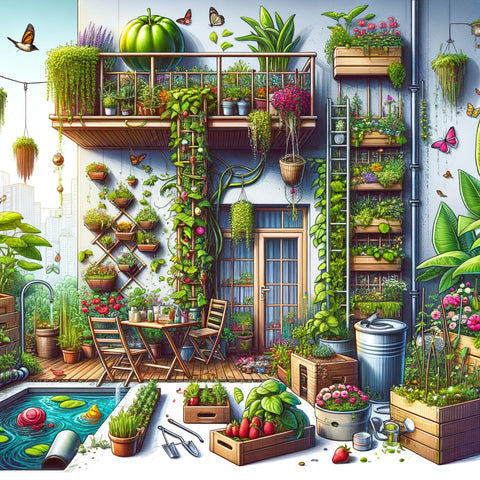Sustainable Design for Small Spaces
Urban Oasis: The Art and Resilience of Small Space Permaculture
Sustainable lifestyle concepts and ecological design may be applied to plots of any size, as demonstrated by small-scale permaculture. Whether it's a little balcony, backyard, or even just a windowsill, I've learned the importance of being efficient, creative, and attentive while working with limited space. Along with the challenges and triumphs of small-space permaculture, I have had many wonderful discoveries and insights that I would want to share with you.
Integrating people and land in harmony to create an independent ecosystem is the central premise of permaculture. Even in a small space, this kind of planning will allow you to make the most of what you have. With the goal of making a haven away from the city, some pots, and a little balcony was the starting point for my foray into small space permaculture.
The significance of vertical planting was the initial lesson I acquired. Climbing was the only option because horizontal movement was severely limited. The tools of the trade were strawberry hanging baskets, vertical herb planters, and trellises for climbing beans. The balcony became a verdant and fruitful garden after some strategic use of vertical space and the addition of additional plant layers.
The companion planting method also emerged as an unexpected innovation. Because of the limited space, it was essential to select plants that could mutually support and encourage one other's growth in a container garden. The traditional trifecta of corn, beans, and squash demonstrated that diverse species can live in close proximity to one another by adapting to various sized containers.
Problems with composting and soil quality necessitated creative remedies. Worm composting became increasingly common when huge compost containers became more difficult to obtain. An odorless worm bin shown that even in the tiniest of areas, sustainable waste management methods can be implemented by turning food scraps into compost that is rich in nutrients.
One of the main goals of the small-space permaculture approach was to decrease water use. There were more complex ways to gather rainwater than just filling buckets with it; one of them was drip irrigation, which sent water straight to the plant roots. The garden was able to withstand dry spells since every last drop of water was used.
In addition to growing food, small-scale permaculture strove to increase biodiversity and create a safe space for pollinators. From bees that visit the flowers to birds that stop by the water feature for a drink, even a little balcony garden may attract many sorts of wildlife. The interdependence of all life and the ability of seemingly minor places to sustain biodiversity were both illustrated by this little ecosystem.
Discovering that one's ability to achieve sustainability and self-sufficiency in a tiny area is directly connected to their degree of imagination, attention, and observation is the greatest thrill of small space permaculture. Following the story's description of a journey of self-discovery and becoming closer to nature, even a little plot of land may become a flourishing paradise.
As we plan this adventure, let's embody small-space permaculture in a way that honors the creativity and perseverance of city gardeners throughout the world. A way to do this is to draw attention to the variety, elegance, and beauty that may coexist in cramped quarters.
following the path of transformation that is incorporating permaculture techniques into constrained urban environments. City dwellers seeking a connection to nature can find inspiration and resourcefulness in the fact that the fundamental principles of permaculture—care for the land, care for people, and fair share—can flourish in any setting, regardless of size.
Repurposing limited space as a platform for creative expression and sustainable living is central to this approach. Vertical gardening is one way to make the most of vertical space; companion planting is another to increase plant health and biodiversity; and small-scale composting systems are a great way to improve soil even if you don't have garden space. Installing water-saving features, such as rainwater collecting systems, is crucial to ensuring that the garden never runs dry.
Even the smallest balconies, patios, or window sills may be transformed into lush paradises via the practice of small space permaculture. Here, urban wildlife can flourish, humans can have a greater connection to nature, and food can be grown. These spaces, which are essentially urban sanctuaries, foster a sense of community among urban gardeners via the exchange of seeds, knowledge, and produce.
Being able to garden in confined urban spaces requires adaptability and imagination, but it's also a sign of resilience. To get around problems like limited room, soil, and sunshine, innovative methods like hydroponics, container gardening, and grow lights are essential. Even the gardeners demonstrate remarkable flexibility; they meticulously analyze their local ecosystems and modify their practices to harmonize with them instead than competing with them.






Leave a comment